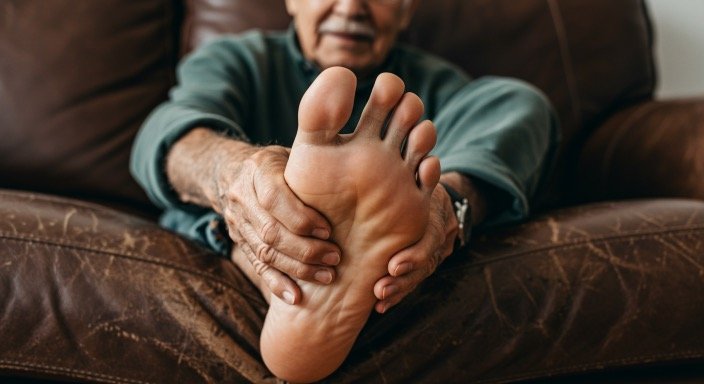Do your feet grow as you get older
Have you ever noticed your favorite pair of shoes suddenly feeling a little snug — even though you haven’t changed your size in years? You might wonder if your feet are actually growing as you get older. It sounds strange, right? After all, most people assume that once you reach adulthood, your body stops growing entirely. But here’s the surprising truth — while your bones stop growing, your feet can still change size and shape over time.
So, what’s really going on? Are your feet actually getting bigger, or is something else at play? Let’s take a closer look at what happens to your feet as you age, what causes these changes, and what you can do to keep them comfortable and healthy.
Can Your Feet Really Grow as You Get Older?
The short answer: yes, but not in the way you think.
According to experts at the Cleveland Clinic, your bones don’t keep growing after your early 20s. However, your ligaments and tendons — the tissues that connect your bones and muscles — can loosen over time. This natural process causes your arches to flatten and your feet to spread out, making them appear longer or wider.
In other words, your feet aren’t technically growing — they’re changing shape due to the effects of aging, gravity, and daily wear and tear. This can add up to half a shoe size (or more) for some people.
Do your feet grow as you get older?
Why Do Feet Change Shape Over Time?

Do your feet grow as you get older?
There are a few major reasons why your feet may seem to grow as you age:
1. Loss of Elasticity and Collagen
As we get older, our skin loses elasticity and collagen — not just in our faces, but throughout our bodies, including our feet. This makes the soft tissue in the feet thinner and less supportive, leading to a flatter arch and longer footprint.
2. Gravity and Daily Stress
Decades of standing, walking, and carrying your body weight take their toll. Over time, gravity causes the arches of your feet to slowly collapse. Even if it’s a small change, it can make your shoes feel tighter or less comfortable.
Read our article: Can Anemia Cause Weight Gain? The Surprising Truth You Need to Know)
3. Weight Fluctuations
Weight gain or loss can also affect the shape of your feet. Extra weight increases pressure on the arches, while weight loss can reduce the fatty padding that cushions the heels and balls of your feet.
4. Health Conditions
Certain health conditions like arthritis, diabetes, or edema (swelling) can lead to foot structure changes. For example, arthritis can cause joint inflammation and deformities, while diabetes can lead to fluid retention that makes feet appear larger.
When to Be Concerned About Foot Changes
While a gradual increase in shoe size is common with age, sudden or painful changes shouldn’t be ignored. If you experience swelling, severe pain, or visible deformities in your feet, it’s best to consult a podiatrist or healthcare professional.
According to the Mayo Clinic, conditions like flat feet or posterior tibial tendon dysfunction (PTTD) can worsen with age and cause discomfort or mobility issues if left untreated. Early intervention can prevent long-term damage.
How Aging Affects Foot Health
Let’s break down what happens to your feet as you move through adulthood into your senior years:
| Age Group | Common Changes | Foot Care Tips |
| 20s–30s | Feet stabilize in size; minor changes may occur after pregnancy or weight shifts. | Wear supportive shoes; avoid high heels for long hours. |
| 40s–50s | Arches begin to flatten; tendons lose elasticity; shoe size may increase. | Choose shoes with arch support and cushioning. |
| 60+ | Skin thins, arches fall further, balance issues increase. | Regular podiatrist visits; consider orthotic inserts. |
Do your feet grow as you get older?
This natural evolution doesn’t mean your feet are “falling apart.” It simply means they’re adapting — much like the rest of your body as you age.
Do Men and Women Experience Foot Growth Differently?
Yes, they can. Women often experience more noticeable changes due to hormonal fluctuations and pregnancy, which can relax ligaments and lead to longer or wider feet even after childbirth.
Men, on the other hand, may experience more gradual flattening caused by weight gain and loss of muscle tone. Both sexes benefit from wearing properly fitted shoes and replacing them every 6–12 months to maintain foot health.
For example, the The Foot Institute notes that wearing supportive shoes can significantly reduce pain caused by collapsed arches and joint strain — a key reason to measure your feet annually, even in adulthood.
How to Tell If Your Feet Have Changed

You don’t need a fancy scan to know if your feet have changed — just pay attention to a few key signs:
- Your old shoes feel tight or pinch your toes.
- You notice your arches look lower when standing.
- Your feet ache after long periods of standing.
- You develop calluses or corns in new areas.
- You need to loosen your shoelaces more than before.
If you’ve noticed any of these, it’s time to remeasure your feet or visit a shoe store that offers professional fitting.
Do your feet grow as you get older?
The Importance of Proper Footwear as You Age
Wearing the right shoes becomes increasingly important as you get older. Shoes that are too tight can cause blisters, bunions, or even balance problems — especially if your feet have changed shape.
Look for shoes with:
- Good arch support
- Roomy toe boxes
- Cushioned soles
- Non-slip bottoms
For more serious issues, custom orthotics (prescribed by a podiatrist) can provide support that standard insoles can’t.
Do your feet grow as you get older?
Lifestyle Tips to Keep Your Feet Healthy
- Stay Active: Regular low-impact exercises like swimming, yoga, or walking improve circulation and foot strength.
- Stretch Your Feet: Gentle stretching reduces stiffness and maintains flexibility.
- Maintain a Healthy Weight: Reduces pressure on your arches and joints.
- Moisturize Daily: Prevents dry, cracked skin and calluses.
- Inspect Your Feet Regularly: Look for swelling, redness, or sores — especially if you have diabetes.
Myths About Feet and Aging
Let’s bust a few common myths:
- ❌ Myth: “Your feet stop changing after 18.”
✅ Truth: Ligaments and tendons can still stretch and flatten well into adulthood. - ❌ Myth: “Foot pain is just part of getting older.”
✅ Truth: Pain isn’t normal — it’s a signal that something’s wrong. Proper shoes and care make a difference. - ❌ Myth: “If my shoes fit, I don’t need new ones.”
✅ Truth: Shoe sizes vary by brand, and your size can change subtly each year. Re-measure regularly!
When to See a Specialist
If you experience persistent swelling, numbness, or sharp pain in your feet, consult a podiatrist or orthopedic specialist. These symptoms can indicate conditions like:
- Plantar fasciitis
- Bunions
- Morton’s neuroma
- Arthritis or tendon disorders
Prompt evaluation ensures proper treatment before problems worsen.
Final Thoughts
So, do your feet grow as you get older? Not exactly — but they do change. Aging, gravity, and lifestyle factors can make your feet appear longer or wider, leading to discomfort if your shoes no longer fit properly.
The key takeaway? Be kind to your feet. They’ve carried you for years — it’s only fair to give them the support they deserve.
Measure your feet annually, invest in well-fitted shoes, and don’t ignore discomfort. These small steps can make a huge difference in keeping you comfortable and mobile as you grow older.
Our Authority Sources
- https://my.clevelandclinic.org/health/diseases/flat-feet-pes-planus
- https://www.mayoclinic.org/diseases-conditions/flatfeet/symptoms-causes/syc-20372604
- https://www.thefootinstitute.com/faqs/shoes-for-foot-pain-el-paso-foot-specialists.cfm







